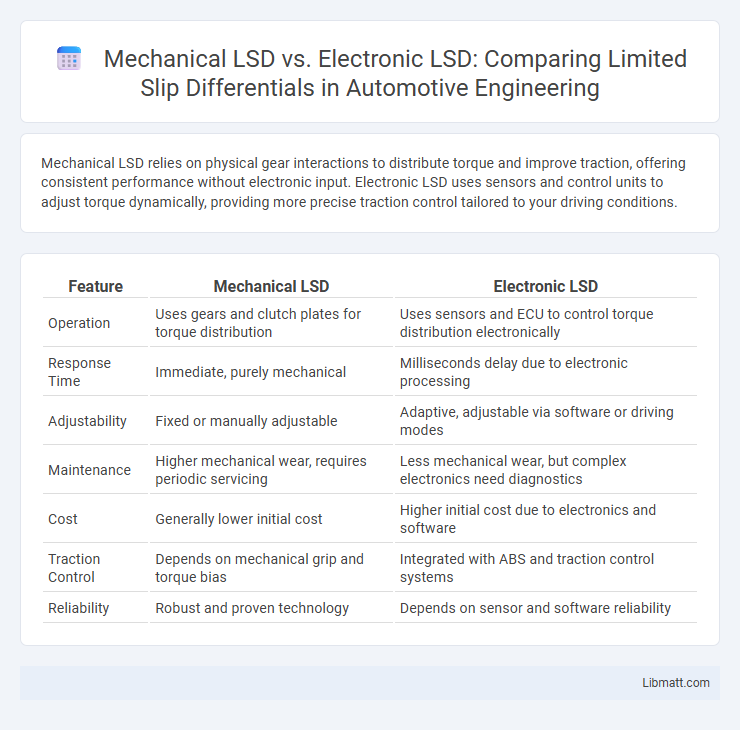Mechanical LSD relies on physical gear interactions to distribute torque and improve traction, offering consistent performance without electronic input. Electronic LSD uses sensors and control units to adjust torque dynamically, providing more precise traction control tailored to your driving conditions.
Table of Comparison
| Feature | Mechanical LSD | Electronic LSD |
|---|---|---|
| Operation | Uses gears and clutch plates for torque distribution | Uses sensors and ECU to control torque distribution electronically |
| Response Time | Immediate, purely mechanical | Milliseconds delay due to electronic processing |
| Adjustability | Fixed or manually adjustable | Adaptive, adjustable via software or driving modes |
| Maintenance | Higher mechanical wear, requires periodic servicing | Less mechanical wear, but complex electronics need diagnostics |
| Cost | Generally lower initial cost | Higher initial cost due to electronics and software |
| Traction Control | Depends on mechanical grip and torque bias | Integrated with ABS and traction control systems |
| Reliability | Robust and proven technology | Depends on sensor and software reliability |
Introduction to Limited Slip Differentials
Limited Slip Differentials (LSDs) enhance traction by distributing torque between wheels to prevent slippage during acceleration or cornering. Mechanical LSDs use clutch packs or gears to physically limit wheel spin, offering durable and predictable performance suited for off-road and performance driving. Electronic LSDs utilize sensors and braking systems to modulate torque electronically, providing adaptable traction control that can be integrated with modern vehicle stability systems to optimize your driving experience.
What is a Mechanical LSD?
A Mechanical LSD (Limited Slip Differential) uses clutch plates or gears to distribute torque between the wheels, improving traction during cornering or on slippery surfaces. It operates based on mechanical friction and forces, providing consistent and predictable power transfer without relying on electronic sensors or controls. Your vehicle benefits from improved handling and stability, especially in off-road or high-performance applications where electronic assistance may be less effective.
What is an Electronic LSD?
An Electronic LSD (Limited Slip Differential) uses sensors and electronic controls to manage torque distribution between wheels, enhancing traction and stability in various driving conditions. Unlike a Mechanical LSD that relies on gears and clutches to transfer torque, the Electronic LSD can adjust torque allocation more precisely and quickly based on real-time data from wheel speed sensors. This system improves vehicle handling, particularly in slippery or dynamic driving environments, by dynamically modulating power delivery without mechanical wear.
Core Functional Differences
Mechanical LSD relies on clutch packs or gear sets to distribute torque between wheels, activating based on physical wheel slip and mechanical forces. Electronic LSD uses sensors and electronic controls to modulate torque distribution actively, allowing for faster response and adjustable settings based on driving conditions. Core functional differences center on the passive, hardware-based operation of mechanical LSD versus the dynamic, software-driven adaptability of electronic LSD.
Performance in Various Driving Conditions
Mechanical LSD delivers consistent torque distribution by using gears or clutch plates, ensuring reliable traction during aggressive cornering or uneven terrain. Electronic LSD adapts torque dynamically through sensors and an ECU, enhancing stability and responsiveness in varied driving scenarios like slippery roads or high-speed maneuvers. Your choice depends on whether you prioritize traditional mechanical reliability or advanced electronic precision for performance in diverse driving conditions.
Maintenance and Longevity
Mechanical LSDs require regular inspection and fluid changes to maintain optimal performance, with clutch wear being a common maintenance concern impacting longevity. Electronic LSDs generally offer reduced mechanical wear due to their use of sensors and actuators, leading to lower maintenance demands and potentially longer service life under typical driving conditions. Proper care of either type, including prompt repairs and adherence to manufacturer guidelines, significantly enhances durability and function.
Cost Comparison and Affordability
Mechanical LSDs tend to be more affordable upfront due to simpler design and widespread availability, making them a cost-effective choice for budget-conscious drivers. Electronic LSDs, while generally more expensive, offer advanced performance and adaptability that justify the higher price for enthusiasts prioritizing vehicle handling. You should weigh initial costs against long-term benefits when deciding which limited slip differential fits your budget and driving needs.
Applications in Modern Vehicles
Mechanical LSDs remain popular in performance and off-road vehicles due to their durability and predictable torque distribution during cornering. Electronic LSDs, integrated with advanced vehicle stability systems, offer precise modulation of torque based on real-time sensor data, enhancing traction and safety in everyday driving conditions. Your choice depends on whether you prioritize rugged reliability or adaptive control for modern vehicle applications.
Pros and Cons: Mechanical vs Electronic LSD
Mechanical LSD offers reliable torque distribution with fewer electronic failures, providing consistent traction in off-road or high-stress conditions but may lack the adaptability of electronic systems. Electronic LSD enhances vehicle stability through precise, real-time adjustments controlled by sensors, improving handling and fuel efficiency, though it depends heavily on electronic components that can malfunction or require complex maintenance. Choosing between mechanical and electronic LSD depends on prioritizing durability and simplicity versus dynamic responsiveness and advanced control.
Choosing the Right LSD for Your Needs
Choosing the right LSD depends on your specific driving conditions and preferences; Mechanical LSDs provide reliable, predictable torque distribution ideal for off-road and track enthusiasts seeking consistent performance. Electronic LSDs offer adjustable settings and rapid response, enhancing traction control in varied road conditions while allowing customizable driving dynamics. Your decision should prioritize whether you need durability and simplicity from a mechanical system or advanced adaptability from an electronic setup.
Mechanical LSD vs Electronic LSD Infographic

 libmatt.com
libmatt.com